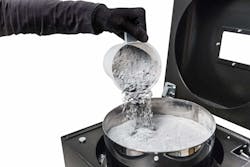SLS Printer Gets a Boost from Comprehensive Software
Autodesk’s Netfabb, an industrial additive software used to optimize CAD files for 3D printing, now supports operations carried out by the Sinterit Lisa. Hailed as one of the most affordable selective laser sintering (SLS) machines on the market, Sinterit Lisa pairs with the industrial software to print 3D parts with a low affinity for errors, and meet needs of users ranging from students to industrial designers.
One of the most outstanding features of Netfabb is its ability to import many CAD file formats. Customers can import files individually or in batches using the Import and Repair feature. Netfabb will then automatically analyze mesh files to find errors that affect the part’s printability. The errors in turn can be fixed using manual or automatic repair tools. Users can also edit their parts using 2D drawings tools, chamfer, and other tools. They can also define etching patterns for the laser-based printer technology.
New features on the Sinterit Lisa include automatic leveling of the powder surface, automatic bed-height setting, and capabilities to print multiple parts on the same working space. The printer’s new sieve increases the speed of removing powder, and allows multiple uses of extra materials. The Automatic Packing feature found in Netfabb Premium and Ultimate versions complements Sinterit Lisa’s ability to print multiple products in a single print job by optimizing the space between parts.
The software can also simulate the print process based on the parameters of the 3D printer and the materials being used. (The Sinterit Lisa, in particular, is made for processing polymer materials.) The print simulation estimates temperature and part strength over the course of printing so that customers can verify their part’s manufacturability.
Autodesk acquired Netfabb in 2015, and has since then began many partnerships with materials and printer companies. In addition to certification with Sinterit Lisa, it is certified for use with HP’s Jet Fusion 3D printing system. Netfabb also has created an Additive Manufacturing Alliance with several materials companies to gather data on 3D printing with various metals and polymers.
About Netfabb
Netfabb is offered in three versions, all of which support jobs carried out by the Sinterit Lisa. While the Basic version is only used to analyze designs for printing with polymer materials, the Premium and Ultimate versions can simulate printing with metals. The basic version enables collaboration between up to five heads on a 3D printer, while the next level versions can manage an unlimited number of print heads.
Premium and Ultimate versions also allow users to design supports and part slices separately. The build-support feature allows users to make tree-and-branch supports, or thin support matrixes that keep the part off of the print bed. It also automatically generates supports where needed.
The Ultimate version of software is useful for designing lightweight parts. Its features can be used to optimize internal lattice structures, and topology—or the geometry of a structure—to meet stiffness and load-handling specifications at the lowest possible part weight. Customers can download the software for a free 30-day trial with all available features.
About the Author
Leah Scully
Associate Content Producer
Leah Scully is a graduate of The College of New Jersey. She has a BS degree in Biomedical Engineering with a mechanical specialization. Leah is responsible for Machine Design’s news items that cover industry trends, research, and applied science and engineering, along with product galleries. Visit her on Facebook, or view her profile on LinkedIn.
